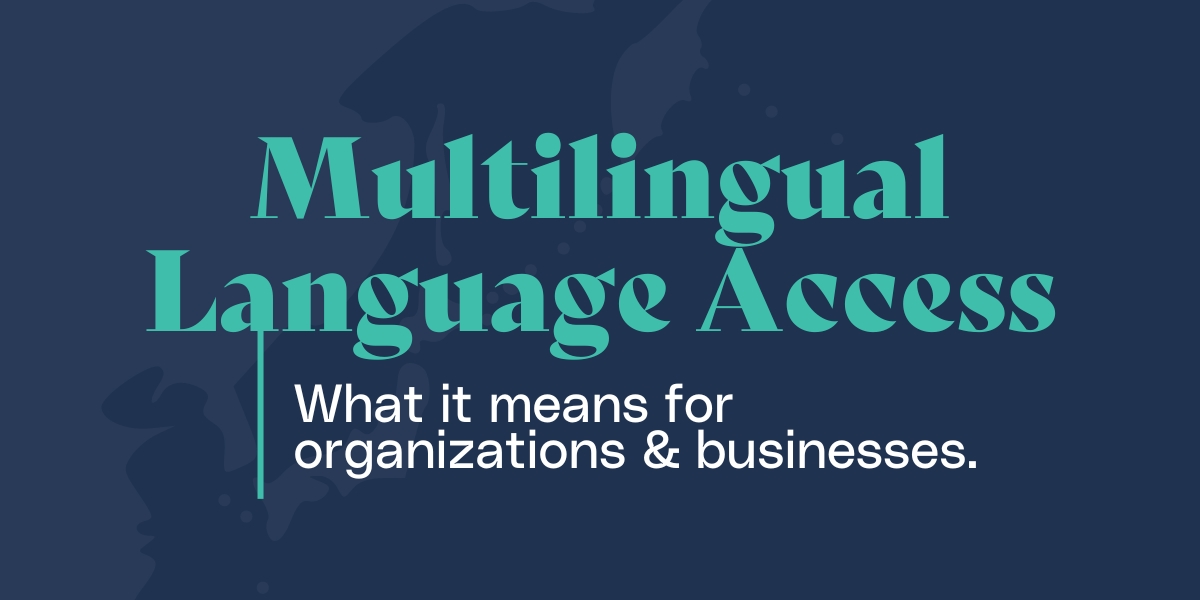What does multilingual language access mean for an organization?
Discover how to use translation as a tool to increase information access for your company and the first steps to begin your language journey.
Our team is invested in providing access to information. Our recently rebranded mission is:
We create stronger relationships through language, and relationships create a better world. Interpro connects people of different cultures worldwide through language while creating long-term partnerships that bridge cultures and remove language barriers.
Language equity and improving information access for individuals who don’t speak English or who speak English as a second language are priorities at Interpro.
Diversity, Equity, and Inclusion (DEI) has been at the forefront of many discussions. Inclusive language is a priority – but is multilingual language a topic in this journey?
If it isn’t, we feel it should be. When done accurately, translation, interpreting, and localization can be a powerful language inclusion tool. Language inclusion is not limited to any single industry. Associations, banking, finance, healthcare, gaming, technology, legal, automotive, manufacturing, travel, tourism, hospitality, retail, and eCommerce (to name a few) can all grow by offering accurate multilingual content.
So, we’re opening the Multilingual Inclusion for Language Access conversation in this blog. We hope that this will spark ideas on how your organization can play a role in helping promote language equity.
Getting Started: What is Multilingual Language Access (regarding building a multilingual-inclusive organization)?
Language inclusion is the active decision to choose words that avoid discrimination, exclusion, or alienation of a group of people.
When this concept is applied to an organization with either internal or external multilingual audiences, it takes on an even deeper meaning.
In other words, people who grew up with a different culture or speak a different language will have different cultural references and dialects. This can make it challenging to navigate and comprehend materials written solely in English.
If your goal is to create an inclusive culture for people who speak languages other than English, one simple yet highly effective step is to localize your materials.
This will overcome language barriers in the most efficient way possible. Localization helps ensure you and your organization are not widening the communication gap between English speakers and those who speak other languages. It often demonstrates that your organization is dedicated to building an inclusive multilingual culture.
Examples of Multilingual Cultural References: An American-to-Spanish Cultural Difference
Cultural references go beyond a shared place of birth or common background. They include experiences that might have a deep impact on message reception.
One Spanish cultural reference Americans may not be familiar with is the “siesta.” Siesta refers to a short nap or rest taken in the early afternoon, typically after lunch.
In many Spanish-speaking countries, particularly in Spain and Latin America, having a siesta is a cultural tradition, especially in warmer regions where the midday heat can be intense. The concept of siesta is deeply ingrained in the Spanish culture and reflects a more relaxed approach to daily life, prioritizing leisure and well-being. This could be a drastic change for a Spanish native in American culture.
Compare this to the American-hustle-get-it-done attitude, in which a workplace nap will likely get a worker disciplined. Many have heard the expression that in the USA, “we live to work,” and in other countries, “they work to live.” Understanding these cultural differences can help ensure that your Spanish-speaking target audience understands and resonates with your message.
Is Multilingual Content Right for Your Organization?
Translations can be used to spearhead diversity and inclusion efforts for internal company training materials, eLearning courses, and communication. Or they can be used externally with clients and end users in marketing, packaging, and other communications.
Translating your content has the potential to increase the visibility of your organization. This has to be done accurately, ideally with human linguists paired with subject matter expertise. Inaccurate translations may look like you’re offering something inclusive, but poor translation or interpretation increases the risk of mistakes and offending a culture. The results could be detrimental.
But the question remains: is the investment in translating materials right for you?
At Interpro, we understand the importance and advantages of accurate multilingual content. But we also know translating all your materials is not the right solution for every organization.
Answer these questions to help determine if using a language service provider for translation or interpretation is right for your organization:
- Does your company want to increase its market reach?
- Does your company want to be part of a global community?
- Does your company want to increase understanding with your current multilingual employees, customers, or members for whom English might be a second language?
- Does your company want to reach more customers in underrepresented markets?
- Is your company in an industry with language inclusion requirements?
If you answered yes to any of these questions, having multilingual content could be right for your business.
The Real Benefits of Translation for a Business
Now imagine that a misunderstanding or offense occurs in the context of a more serious subject matter, such as:
- how to operate heavy machinery safely
- setting up your insurance benefits
- providing medical care
- an important legal contract
- a critical marketing campaign
Injuries, disastrous life-changing misunderstandings, or tanked sales can be serious results.
Translating your materials isn’t just a nice-to-have benefit in these critical situations. Potential misunderstandings due to a language barrier or incorrect translation could cause safety, legal, or financial issues for both your audience and your business.
Translating your organization’s materials is a great way to increase access, improve understanding, remove language barriers, and reduce risk. We like to think that when you translate the content, you reach your audience where they feel most comfortable.
Learning in one’s own native language has been shown to increase retention and reduce misunderstanding and situational disability. Situational Disability can occur often when visiting or residing in a foreign country without knowing the language.
Now that we’ve defined language inclusion and understand the benefits of translation for an organization, what can you do about it?
How to Start Your Organization’s Multilingual Language Access Journey
Organizations prioritizing quality know that you must bridge the gap between your experience and your reader’s experience. That’s where localization is a tool to promote language inclusion.
Although it’s unrealistic to offer all your content in every single language (there are over 200 modern languages still in use today), it is possible to take the first step: assessing and asking your audience about their language needs.
Once a single need is established, you can begin your journey by acting on that information and providing just one piece of material in one language.
We’ve seen organizations do the following for multilingual language access:
- Localize manuals, eLearning courses, videos, or safety instructions.
- Translate legal agreements, insurance benefits, or medical information.
- Localize website content and online educational information.
- Offer interpreting for meetings, conferences, and events.
These are only a few ways to begin your multilingual language access journey. After establishing a single need, involve a localization strategist for a more custom approach for your business. Accurately localizing your materials will only help your organization communicate more effectively with your audience.
Interpro’s Experience with the Multilingual Language Access Landscape
Multilingual is Inclusive
We believe that translation and localization are critical to an organization’s DEI efforts. We see more and more companies discovering translation as a tool for inclusivity.
A good translation can demonstrate the organization’s dedication to accessible information in many ways, such as:
- Encouraging diversity by engaging and representing different cultures in written materials and spoken events.
- Increasing equity through comprehension and removing language barriers.
- Allowing inclusive access to information for people of different cultures and languages.
Global is Local
Interpro originally began by working with organizations that required localizing materials for international audiences (i.e., organizations selling products to customers globally) – but over the years, our team has helped more and more organizations translate exclusively for multilingual audiences based in the United States.
Representing multiple languages in your content can have an immense competitive advantage. Sixty-eight million people in the U.S. speak a language other than English at home. Depending on the industry, a higher percentage of the audience may use a language other than English at home.
The shift from translating for only international audiences to domestic audiences is why Interpro wants to join your writing process long before the translation stage begins. We want your message to translate well because accurate information access is critical.
Building an inclusive and multilingual company culture begins with a multilingual audience that is already local and listening.
Multilingual Help is Here
We take pride in assisting our clients with their English materials, even before completion. That includes helping them write content that will be considered localization-friendly.
Each target language can be different, and languages evolve on an organic basis. We’ve found the best approach for sensitive subjects is consulting with our in-country teams of linguists. Translation teams that are focused on the end user and dedicated to professional localization can often solve these potential translation issues, including:
- Content that might be considered taboo.
- Emotionally-charged content.
- Offensive cultural differences (meaning of colors, attire, symbols, phrase structure, etc.)
Because Interpro delivers all of its work in accordance with ISO 9001:2015 and ISO:17100 certifications, we implement several quality assurance steps and a highly detailed localization process. This can include adapting names, foods, ingredients, dates, formatting, money, slang, and more to the target language. Long story short, we take all measures possible to avoid publishing subpar translations.
We care deeply about each client’s language needs, and that makes accurate translations for information access simple. We aim to keep growing our resources on the subject as it evolves. If you have any questions, please ask them here.
Thank you for joining Interpro on our language access journey. We are here to help you with any questions about beginning your multilingual inclusion journey.

ADA Compliance and Web Accessibility: How Localization Can Help

Subtitle Translation: Making Your Videos More Accessible and Engaging

Why Associations Need a Professional Localization Agency: Benefits and Best Practices

Fostering Global Inclusion: The Role of International Associations


